Search Results for Tag: Rescue
Latok I: How high did Gukov and Glazunov climb?
No photo, no video, no GPS data. It’s not possible to prove clearly where exactly on the seven-thousander Latok I in the Karakoram the two Russian climbers Alexander Gukov and Sergey Glazunov finished their ascent on 23 July. The GPS tracker didn’t work properly. The mini-camera they had used to document the ascent was carried by Sergey when he fell to his death on 25 July. The body of the 26-year-old could not be recovered. Two days before, the two Russians had reached their highest point in the fog. “By 7 pm, Sergey climbed up a small col between a rock and a snowy serac. I was standing ten meters below him. The snow was almost vertical,” Alexander recalls on “mountain.ru”, where an English translation of his statements was published today.
![]() read more
read more
Thomas Huber before his expedition to 7000er Latok I: “Complex and difficult”
Thomas Huber is sitting on packed expedition barrels. “I’m really looking forward to the expedition,” says the 51-year-old. The older of the two Huber brothers is leaving for Pakistan this Saturday. Thomas wants to tackle the northern side of the 7,145-meter-high Latok I – together with 33-year-old South Tyrolean Simon Gietl and climbing old hand Rainer Treppte, aged 59, who comes from Saxony and has been living in the Allgäu region for a long time. “I have already climbed with them,” says Huber about his two climbing partners. Last spring, the trio succeeded in repeating for the first time the difficult “La Strada” route on the Cima Grande in the Dolomites, which the Poles Piotr Edelman and Jan Fialkowski had mastered for the first time in 1988. “We harmonize very well as a team, and we have every chance to tackle such a goal as Latok I,” says Thomas Huber. I also talked to him about the drama on this seven-thousander in the Karakoram that had kept us in suspense for days.
Thomas, yesterday we got the relieving message that the Russian climber Alexander Gukov was rescued from the North Ridge of Latok I. How did you experience this dramatic story?
![]() read more
read more
Alexander Gukov rescued from Latok I
Good news from the Karakoram: Alexander Gukov is saved. The 42-year-old Russian climber had been trapped for almost a week on the North Ridge of the seven-thousander Latok I at 6,200 meters, without food or equipment. With finally good visibility, but strong wind, Pakistani helicopter pilots managed to get Alexander off the mountain on a long line. Two helicopters were in action.
![]() read more
read more
Still no rescue of Gukov possible
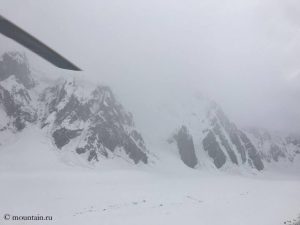 The drama on Latok I continues. Another day has passed on which Alexander Gukov is trapped on the North Ridge of the seven-thousander in the Karakoram without any help. Like throughout the weekend, thick clouds today prevented rescue helicopters from approaching the site at around 6,200 meters, where the 42-year-old Russian climber has been staying since Wednesday last week – without food or equipment. The helicopters took off, but returned without getting close to Gukov. “There will be no further attempts today,” mountain.ru reported. “The weather is getting worse.” It’s like bewitched. “Imagine everything is clear, only the Latok is completely in clouds,” said Viktor Koval from the base camp. “The pilots hardly managed to fly away.”
The drama on Latok I continues. Another day has passed on which Alexander Gukov is trapped on the North Ridge of the seven-thousander in the Karakoram without any help. Like throughout the weekend, thick clouds today prevented rescue helicopters from approaching the site at around 6,200 meters, where the 42-year-old Russian climber has been staying since Wednesday last week – without food or equipment. The helicopters took off, but returned without getting close to Gukov. “There will be no further attempts today,” mountain.ru reported. “The weather is getting worse.” It’s like bewitched. “Imagine everything is clear, only the Latok is completely in clouds,” said Viktor Koval from the base camp. “The pilots hardly managed to fly away.”
![]() read more
read more
Fear for Alexander Gukov on Latok I
Alexander Gukov must persevere. This Friday, dense clouds covered the 7,145-meter-high Latok I in the Karakoram in Pakistan. The helicopter of the Pakistan army, with which the 42-year-old Russian mountaineer is to be rescued from the North Ridge, stayed on the ground. As reported yesterday, Gukov is trapped at 6,200 meters without equipment, his rope partner Sergey Glazunov had fallen to his death while abseiling. “Damn! Where do all the avalanches come from? I can’t even boil water,” Alexander wrote to Anna Piunova from mountain.ru by SMS today. Later he sounded a little more optimistic: “I managed to find half a Snicker and also drink some water.” His food supplies have run out after more than two weeks on the mountain.
![]() read more
read more
A drone for rescue and more summit successes in the Karakoram
For me, drones come right after leaf blowers. I find the noise generated by the increasingly popular flying machines extremely annoying. Drones sound like mutated giant bumblebees. Torture for my ears. But even I have to admit: On the eight-thousander Broad Peak in the Karakoram in Pakistan, a drone and the guy who flew it did a great job. Eight days ago, on 9 July, the 64-year-old Briton Rick Allen set off alone for a summit attempt. His teammates stayed in Camp 3 at 7,000 meters. When Rick didn’t return, they sounded the alarm because they feared Allen might have been injured or even died. Sandy Allan, who had already descended to base camp due to strong winds in the summit area, contacted the Polish Bargiel brothers in the nearby K2 Base Camp. Andrzej Bargiel is planning to ski the second highest mountain in the world from the summit to base camp for the first time this summer. His brother Bartek is filming the project – also using a drone.
![]() read more
read more
Climber dies in avalanche in Pakistan
An Austrian climber was killed in an avalanche accident on the 7,338-meter-high Ultar Sar in the Karakoram. Christian Huber died on Friday when the snow masses hit the tent he and his team-mates Bruce Normand and Timothy Miller had pitched on a ridge at an altitude of 5,800 meters. The two uninjured British and the body of Huber were taken from the mountain this Sunday by a rescue helicopter of the Pakistani army. An army spokesman said it was a “daring mission”. The first emergency call had been received on Saturday morning. Bad weather had prevented the helicopter from taking off earlier.
![]() read more
read more
Death on Cho Oyu
The good news first: The finished spring season in the Himalayas has shown that coordinated rescue operations for climbers in serious trouble are also possible in Tibet. For example, the Chinese authorities even allowed the use of Nepalese rescue helicopters in the case of the Bulgarian Boyan Petrov, missing on the eight-thousander Shishapangma. At the same time, a team consisting of three Sherpas and three Chinese climbers, was searching for Boyan directly on the mountain’s slopes. Unfortunately in vain. But the cooperation between Nepalese and Tibetan rescuers could have set standards for the future. Also on the 8,188-meter high Cho Oyu, a three-person Chinese-Tibetan rescue team was deployed immediately after an emergency call. Now for the bad news: As with Petrov, there was no happy ending in this case too. And the world hasn’t heard about it either –till today.
![]() read more
read more
Nanga Parbat: Revol’s anger after the rescue
“We could have saved Tomek.” With this sentence, the French mountaineer Elisabeth Revol has triggered a debate. Could her Polish rope partner Tomek Mackiewicz still be alive, whom, suffering from severe high altitude sickness and slowblindness after their summit success on Nanga Parbat, she had had to leave at 7,200 meters, if the rescue at the end of January had started faster? On the late evening of 25 January, Revol had made several emergency calls. “It’s a race against the clock when you set off a rescue,” Elisabeth said at a press conference in Chamonix on Wednesday. “It took, in fact, 48 hours for something to happen. So clearly I have a lot of anger inside of me – and Tomek could have been saved if it had been a real rescue carried out in time and organized.”
![]() read more
read more
Nanga Parbat: Triumph and tragedy
The ridge is narrow at the highest mountains in the world, between luck and danger, between life and death. On Thursday of last week, Elisabeth Revol and Tomek Mackiewicz reached the 8,125-meter-high summit of Nanga Parbat. Elisabeth was the first woman to succeed a winter ascent of this eight-thousander, Tomek the first Pole to set foot on the highest point of Nanga Parbat in the cold season. In the seventh attempt Mackiewicz had finally fulfilled his big dream. For Revol, it was the third attempt, all together with Tomek. The two climbers did not have time to enjoy the second winter ascent of Nanga Parbat on the summit. They were late, it was already 6 pm local time and dark. That was still the smaller problem. “Tomek told me ‘I can’t see anything any more’,” Elisabeth reports from a French hospital, where her severe frostbite on her hands and feet is being treated. “He hadn’t used a mask because it was a bit hazy during the day and by nightfall he had ophthalmia (an inflammation of the eye). We hardly had a second at the top. We had to rush to get down.”
![]() read more
read more
No more hope for Zerain and Galvan
The two climbers Alberto Zerain and Mariano Galvan were most likely killed in an avalanche accident on Nanga Parbat. A rescue helicopter from the Pakistani army has now discovered an avalanche cone at the place from where the last signal from the GPS tracker was sent last Saturday. During two flights today the helicopter crew found no trace of the 55-year-old Spaniard Zerain and the 37-year-old Argentinian Galvan. “This situation unfortunately excludes the possibility of finding survivors,” said Alberto Zerain’s team.
Experienced eight-thousander climbers
![]() read more
read more
Missing trekkers found in Nepal after 47 days
Mountain rescuers in the Alps often complain about climbers or hikers, who overestimate their abilities, suddenly can not move neither forward nor back and have to be rescued from this precarious situation on the mountain. That’s what happened to a young couple from Taiwan, who were on a trekking tour in the mountains of Nepal, more precisely in Langtang, without a guide. The two had been missing for 47 days. Now rescuers found the 21-year-old man lying unconsciously in a cave at the foot of a rock, his 19-year-old girlfriend was dead. According to the Taiwanese she had died three days earlier.
![]() read more
read more
Alex Txikon’s Everest dream team
Danger welds together. When Alex Txikon returned to Base Camp after six exhausting and exciting days on the slopes of Mount Everest, he hugged every Sherpa who had accompanied him. “In this team everyone knows what needs to be done,” the 35-year-old Basque writes in his blog. The appreciation is mutual. In Alex’ words, Norbu Sherpa told him during the descent: “I believe that for more than 20 or 30 years, no westerner has done what you are doing.” Like the six Sherpas, Txikon had carried up loads of more than 30 kilograms through the Khumbu Icefall and further up.
![]() read more
read more
Mourning for US climbers Dempster and Adamson
Thomas Huber‘s new Karakoram adventure began with a rescue mission. The German top climber’s exact local knowledge on the Ogre (also called Baintha Brakk) was in demand. About a week ago (I report on it only now because I was on holiday in the Alps at that time) the 49-year-old was picked up by a Pakistani rescue helicopter to search along with the crew for the missing Kyle Dempster and Scott Adamson. In vain. No sign of the Americans. In the end the search was canceled because there was no more hope of finding them alive.
![]() read more
read more
Rescue on Everest completed
All climbers from the high camps on Mount Everest are safe. In the morning the last 17 climbers, who had been stranded at Camp 1 at 6,100 meters, nine Sherpas and eight foreigners, were flown down to the valley by helicopter. An official of the Nepalese Tourism Ministry said, more than 200 climbers had been rescued on Everest. It was the most extensive rescue operation in the history of high altitude mountaineering. According to department reports, at least 19 climbers, including five foreign nationals, have been confirmed dead in two avalanches. It seems that this figure also includes three Sherpas who reportedly died in the Khumbu Icefall during an aftershock on Sunday.
![]() read more
read more



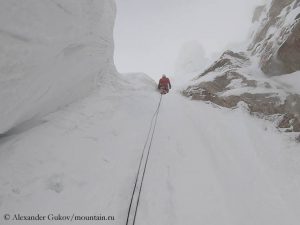


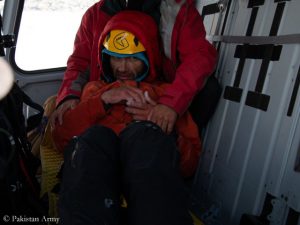
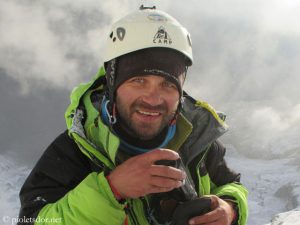
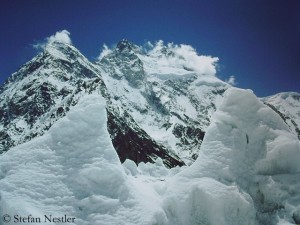
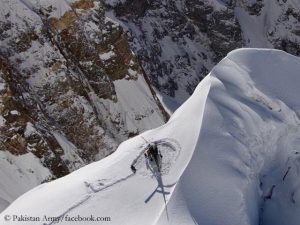
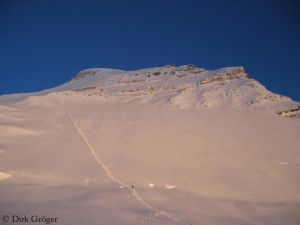

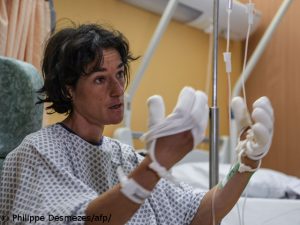

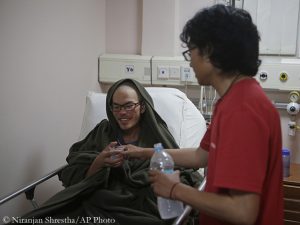
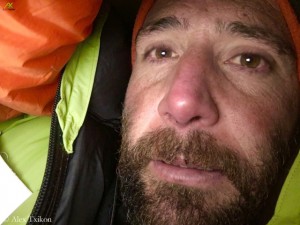
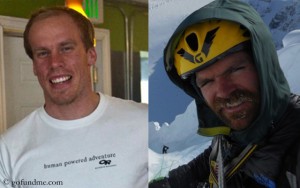
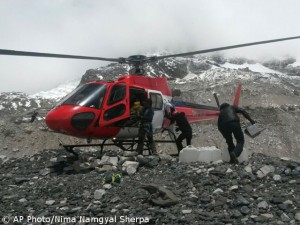





Feedback